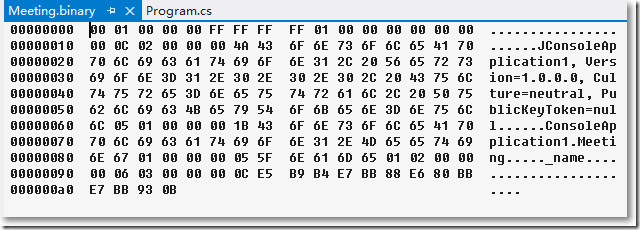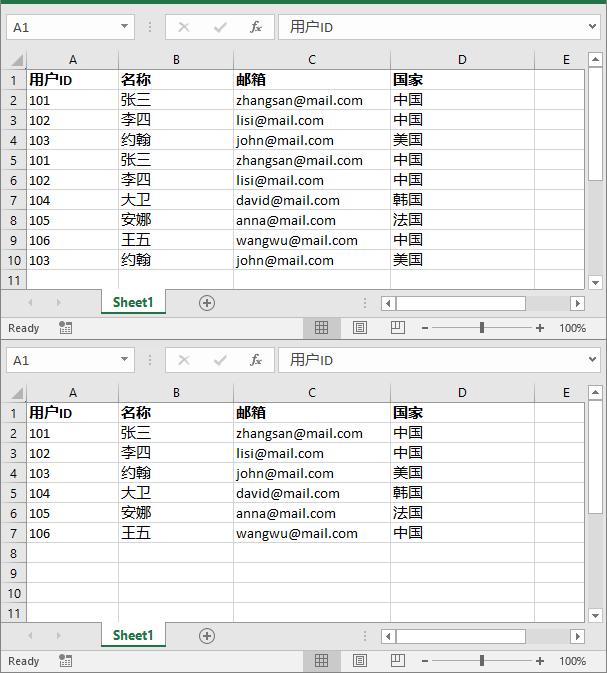序列化是将对象转换成字节流的过程,反序列化是把字节流转换成对象的过程。对象一旦被序列化,就可以把对象状态保存到硬盘的某个位置,甚至还可以通过网络发送给另外一台机器上运行的进程。本篇主要包括:
使用BinaryFormatter类进行序列化和反序列化
使用ISerializable接口自定义序列化过程
使用XmlSerializer类进行序列化和反序列化
使用BinaryFormatter类进行序列化和反序列化
首先把需要序列化的类打上[Serializable]特性,如果某个字段不需要被序列化,就打上[NonSerialized]特性。
|
1 2 3 4 5 6 7 8 9 10 11 12 |
[Serializable] public class Meeting { public string _name; [NonSerialized] public string _location; public Meeting(string name, string location) { this._name = name; this._location = location; } } |
对象序列化后需要一个载体文件,以下的Meeting.binary文件用来存储对象的状态。
|
1 2 3 4 5 6 7 8 9 10 11 12 13 14 15 16 17 18 19 20 21 22 23 24 25 26 27 28 29 30 31 32 |
static void Main(string[] args) { Meeting m1 = new Meeting("年终总结","青岛"); Meeting m2; //先序列化 SerializedWithBinaryFormatter(m1,"Meeting.binary"); m2 = (Meeting) DeserializeWithBinaryFormatter("Meeting.binary"); Console.WriteLine(m2._name); Console.WriteLine(m2._location ?? "_location字段没有被序列化"); Console.ReadKey(); } //序列化 static void SerializedWithBinaryFormatter(object obj, string fileName) { //打开文件写成流 Stream streamOut = File.OpenWrite(fileName); BinaryFormatter formatter = new BinaryFormatter(); //把对象序列化到流中 formatter.Serialize(streamOut, obj); //关闭流 streamOut.Close(); } //反序列化 static object DeserializeWithBinaryFormatter(string fileName) { //打开文件读成流 Stream streamIn = File.OpenRead(fileName); BinaryFormatter formatter = new BinaryFormatter(); object obj = formatter.Deserialize(streamIn); streamIn.Close(); return obj; } |
Meeting.binary文件在bin/debug文件夹中。
使用ISerializable接口自定义序列化过程
如果想对序列化的过程有更多的控制,应该使用ISerializable接口,通过它的GetObjectData方法可以改变对象的字段值。
|
1 2 3 4 5 6 7 8 9 10 11 12 13 14 15 16 17 18 19 20 21 22 23 24 25 |
[Serializable] public class Location : ISerializable { public int x; public int y; public string name; public Location(int x, int y, string name) { this.x = x; this.y = y; this.name = name; } protected Location(SerializationInfo info, StreamingContext context) { x = info.GetInt32("i"); y = info.GetInt32("j"); name = info.GetString("k"); } public void GetObjectData(SerializationInfo info, StreamingContext context) { info.AddValue("i", x + 1); info.AddValue("j", y + 1); info.AddValue("k", name + "HELLO"); } } |
以上,不仅要实现接口方法GetObjectData,还需要提供对象的重载构造函数,从SerializationInfo实例中获取值。
在客户端:
|
1 2 3 4 5 6 7 8 9 |
Location loc1 = new Location(1,2,"qingdao"); Location loc2; //序列化 SerializedWithBinaryFormatter(loc1, "Location.binary"); loc2 = (Location) DeserializeWithBinaryFormatter("Location.binary"); Console.WriteLine(loc2.x); Console.WriteLine(loc2.y); Console.WriteLine(loc2.name); Console.ReadKey(); |
以上,使用BinaryFormatter类进行序列化和反序列化,存储的文件格式是二进制的,例如,打开Meeting.binary文件,我们看到:

有时候,我们希望文件的格式是xml。
使用XmlSerializer类进行序列化和反序列化
XmlSerializer类进行序列化的存储文件是xml格式。用XmlSerializer类进行序列化的类不需要打上[Serializable]特性。
|
1 2 3 4 5 6 7 8 9 10 11 12 13 14 15 16 17 18 19 20 |
public class Car { [XmlAttribute(AttributeName = "model")] public string type; public string code; [XmlIgnore] public int age; [XmlElement(ElementName = "mileage")] public int miles; public Status status; public enum Status { [XmlEnum("使用中")] Normal, [XmlEnum("修复中")] NotUse, [XmlEnum("不再使用")] Deleted } } |
在客户端:
|
1 2 3 4 5 6 7 8 9 10 11 12 13 14 15 |
//打开写进流 Stream streamOut = File.OpenWrite("Car.xml"); System.Xml.Serialization.XmlSerializer x = new XmlSerializer(car1.GetType()); //序列化到流中 x.Serialize(streamOut, car1); streamOut.Close(); //打开读流 Stream streamIn = File.OpenRead("Car.xml"); //反序列化 Car car2 = (Car) x.Deserialize(streamIn); Console.WriteLine(car2.type); Console.WriteLine(car2.code); Console.WriteLine(car2.miles); Console.WriteLine(car2.status); Console.ReadKey(); |
运行,打开bin/debug中的Car.xml文件如下:
|
1 2 3 4 5 6 |
|
- 类名Car成了xml的根节点
- 打上[XmlAttribute(AttributeName = "model")]特性的字段变成了根节点的属性,AttributeName为属性别名
- 枚举项可打上[XmlEnum("使用中")]特性
如果一个类中包含集合属性,比如以下的Department类包含一个类型List
|
1 2 3 4 5 6 7 8 9 10 11 12 13 14 15 16 17 18 19 20 21 22 |
public class Department { public Department() { Employees = new List } public string Name { get; set; } [XmlArray("Staff")] public List } public class Employee { public string Name { get; set; } public Employee() {
} public Employee(string name) { Name = name; } } |
在客户端:
|
1 2 3 4 5 6 7 8 9 10 11 12 13 14 15 |
class Program { static void Main(string[] args) { var department = new Department(); department.Name = "销售部"; department.Employees.Add(new Employee("张三")); department.Employees.Add(new Employee("李四")); XmlSerializer serializer = new XmlSerializer(department.GetType()); //打开写进流 Stream streamOut = File.OpenWrite("Department.xml"); serializer.Serialize(streamOut, department); streamOut.Close(); } } |
查看bin/debug中的Department.xml文件。
|
1 2 3 4 5 6 7 8 9 10 11 12 |
|
总结:
- 1、使用BinaryFormatter类序列化到二进制文件
- 2、使用XmlSerializer类序列化到xml文件
- 3、使用ISerializable接口自定义序列化过程

